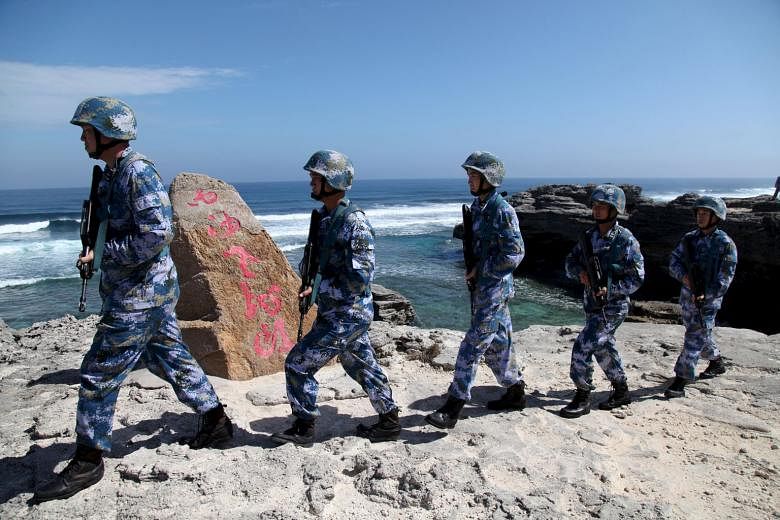The timing of China's reported deployment last week of a surface-to-air-missile (SAM) system to the Paracel chain of islands couldn't be more telling. It coincided with the conclusion of the much-touted summit between US President Barack Obama and the leaders of the Association of South-east Asian Nations (Asean) at Sunnylands estate, California.
During the "short-sleeve" summit, which was met with much fanfare and compared to the 2013 meeting between Mr Obama and Chinese President Xi Jinping at the same place, the US administration managed to garner the support of Asean to issue a joint statement, which reads as an implicit, but unmistakable, criticism of China's increasingly assertive posturing in the South China Sea.
China's latest move on Woody Island also came weeks after the US conducted its latest Freedom of Navigation Operations (Fonops) aimed at challenging what it views as Beijing's excessive sovereignty claims in adjacent waters. Whether it likes it or not, Asean is rapidly approaching a critical juncture, making it increasingly difficult for South-east Asian countries to adopt a passive position on the issue.
Asia's smaller powers are confronting a strategic moment of truth, especially as maritime disputes in the region escalate to dangerous levels. Asean will have to either regain its centrality in managing (if not resolving) brewing regional crises, or risk irrelevance and, even worse, being forced to make a strategic choice between the US and China.
After months of pro-active lobbying, aided by Secretary of State John Kerry's crucial visit to Laos and Cambodia (widely seen as China's staunchest allies) earlier this year, the US administration pushed for a modicum of consensus among Asean leaders on the South China Sea issue.
Crucially, the US appears to have received a guarantee from Laos - the current chair of Asean, which just underwent a crucial leadership reshuffle - that it will not block the discussion of the maritime disputes. China has repeatedly opposed even the discussion of the territorial spats at regional fora, arguing that these should be handled on a bilateral basis.

In their joint statement from Sunnylands, Mr Obama and Asean leaders expressed their shared "commitment to peaceful resolution of disputes, including full respect for legal and diplomatic processes, without resorting to threat or use of force, in accordance with universally recognised principles of international law and the 1982 United Nations Convention of the Law of the Sea" (Unclos)".
The emphasis on "non-militarisation and self-restraint" could very well be directed at China's recent decision to re-deploy SAMs to the Paracel chain of islands as well as its ongoing construction of airstrips and other dual-purpose facilities across the South China Sea. It is a development that the US and its allies contend contradicts the pledge by President Xi, during his state visit to Washington, to not "militarise" the disputes.
China's Defence Ministry has downplayed the SAM deployment to the Paracels, accusing the West of manufacturing "hype" over the issue; meanwhile, Foreign Minister Wang Yi justified it as China's right to establish "limited and necessary self-defence facilities" on land features that it considers as its own, especially in light of what it sees as Washington's Fonops close to its occupied features.
China has also pointed out that the US' emphasis on international law is ironic since it is yet to ratify Unclos.
But Washington and some of its allies fear that Beijing may move ahead with deploying SAMs, radars, jet fighters and other advanced military platforms to its newly-minted installations and airstrips in the Spratly chain of islands, where Asean claimant states Malaysia, Vietnam and the Philippines have precariously maintained civilian and military presence.
Worried about the prospect of a China-dominated South China Sea, regional powers such as India and Japan have also expressed their interest in conducting Fonops in the area, potentially in tandem with the US Navy. American allies such as the Philippines have openly warned about the likelihood that China will soon establish a de facto Air Defence Identification Zone in the area, giving Beijing the ability to restrict the supply lines and reconnaissance operations of weaker claimant states.
Paradoxically, US efforts at militarily challenging China's sweeping territorial claims seem to have only encouraged Beijing to consolidate its position in adjacent waters. This means Asean should step up to the plate and find a peaceful, dialogue-based resolution to the maritime spats in the area.
It is high time for Asean to, for instance, wrap up its long-drawn discussions on a legally-binding Code of Conduct in the area or, at the very least, unambiguously call on all claimant states to freeze any reclamation activity, desist from deploying military platforms to disputed land features, and shun any coercive measure aimed at intimidating rival claimant states.
While Asean is neutral on the status of sovereignty claims in the South China Sea, it has to seize the initiative and start playing a meaningful role in steering claimant states away from actions that undermine freedom of navigation and overflight, as well as threaten broader regional maritime security.
Otherwise, Asean will be at the mercy of a Sino-American conflict, which will not be in anyone's interest.
•The writer is a political science professor at De La Salle University in the Philippines.
•S.E.A. View is a weekly column on South-east Asian affairs.


